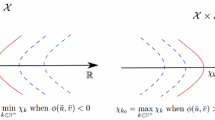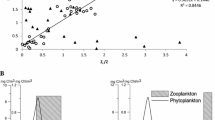Abstract
While it is somewhat well known that spatial PDE extensions of the Rosenzweig–MacArthur predator–prey model do not admit spatial pattern formation through the Turing mechanism, in this paper we demonstrate that the addition of allochthonous resources into the system can result in spatial patterning and colony formation. We study pattern formation, through Turing and Turing–Hopf mechanisms, in two distinct spatial Rosenzweig–MacArthur models generalized to include allochthonous resources. Both models have previously been shown to admit heterogeneous spatial solutions when prey and allochthonous resources are confined to different regions of the domain, with the predator able to move between the regions. However, pattern formation in such cases is not due to the Turing mechanism, but rather due to the spatial separation between the two resources for the predator. On the other hand, for a variety of applications, a predator can forage over a region where more than one food source is present, and this is the case we study in the present paper. We first consider a three PDE model, consisting of equations for each of a predator, a prey, and an allochthonous resource or subsidy, with all three present over the spatial domain. The second model we consider arises in the study of two independent predator–prey systems in which a portion of the prey in the first system becomes an allochthonous resource for the second system; this is referred to as a predator–prey–quarry–resource–scavenger model. We show that there exist parameter regimes for which these systems admit Turing and Turing–Hopf bifurcations, again resulting in spatial or spatiotemporal patterning and hence colony formation. This is interesting from a modeling standpoint, as the standard spatially extended Rosenzweig–MacArthur predator–prey equations do not permit the Turing instability, and hence, the inclusion of allochthonous resources is one route to realizing colony formation under Rosenzweig–MacArthur kinetics. Concerning the ecological application, we find that spatial patterning occurs when the predator is far more mobile than the prey (reflected in the relative difference between their diffusion parameters), with the prey forming colonies and the predators more uniformly dispersed throughout the domain. We discuss how this spatially heterogeneous patterning, particularly of prey populations, may constitute one way in which the paradox of enrichment is resolved in spatial systems by way of introducing allochthonous resource subsidies in conjunction with spatial diffusion of predator and prey populations.


























Similar content being viewed by others
References
Adams LG, Farley SD, Stricker CA, Demma DJ, Roffler GH, Miller DC, Rye RO (2010) Are inland wolf–ungulate systems influenced by marine subsidies of Pacific salmon? Ecol Appl 20(1):251–262
Alonso D, Bartumeus F, Catalan J (2002) Mutual interference between predators can give rise to turing spatial patterns. Ecology 83(1):28–34
Aly S, Kim I, Sheen D (2011) Turing instability for a ratio-dependent predator–prey model with diffusion. Appl Math Comput 217(17):7265–7281
Angerbjorn A, Tannerfeldt M, Erlinge S (1999) Predator–prey relationships: arctic foxes and lemmings. J Anim Ecol 68(1):34–49
Banerjee M, Banerjee S (2012) Turing instabilities and spatio-temporal chaos in ratio-dependent Holling–Tanner model. Math Biosci 236(1):64–76
Banerjee M, Petrovskii S (2011) Self-organised spatial patterns and chaos in a ratio-dependent predator–prey system. Theor Ecol 4(1):37–53
Barnes VG Jr (1990) The influence of salmon availability on movements and range of brown bears on southwest Kodiak Island. In: Bears: their biology and management. A selection of papers from the eighth international conference on bear research and management, vol. 8. Victoria, British Columbia, Canada, pp 305–313. https://www.jstor.org/stable/3872933
Bartumeus F, Alonso D, Catalan J (2001) Self-organized spatial structures in a ratio-dependent predator–prey model. Physica A 295(1–2):53–57
Bassett A, Krause AL, Van Gorder RA (2017) Continuous dispersal in a model of predator–prey-subsidy population dynamics. Ecol Model 354:115–122
Bauer JW, Logan KA, Sweanor LL, Boyce WM (2005) Scavenging behavior in puma. Southwest Nat 50(4):466–471
Baurmann M, Gross T, Feudel U (2007) Instabilities in spatially extended predator–prey systems: spatio-temporal patterns in the neighborhood of Turing–Hopf bifurcations. J Theor Biol 245(2):220–229
Begon M, Howarth R, Townsend C (2014) Essentials of ecology, 4th edn. Wiley, Hoboken
Ben-David M, Blundell GM, Kern JW, Maier JA, Brown ED, Jewett SC (2005) Communication in river otters: creation of variable resource sheds for terrestrial communities. Ecology 86(5):1331–1345
Berns VD, Hensel RJ (1972) Radio tracking brown bears on Kodiak Island. In: Bears: their biology and management. A selection of papers from the second international conference on bear research and management, IUCN Publications New Series, vol. 2. Calgary, Alberta, Canada, pp. 19-25. https://www.jstor.org/stable/3872564
Berns VD, Atwell GC, Boone DL (1980) Brown bear movements and habitat use at Karluk Lake, Kodiak Island. In: Bears: their biology and management. A selection of papers from the fourth international conference on bear research and management, vol. 4. Kalispell, Montana, USA, pp 293–296. https://www.jstor.org/stable/3872883
Camara BI, Aziz-Alaoui M (2009) Turing and Hopf patterns formation in a predator–prey model with Leslie–Gower-type functional response. Dyn Contin Discrete Impuls Syst B 16(4):479–488
Castets V, Dulos E, Boissonade J, De Kepper P (1990) Experimental evidence of a sustained standing Turing-type nonequilibrium chemical pattern. Phys Rev Lett 64(24):2953
Darimont CT, Paquet PC, Reimchen TE (2008) Spawning salmon disrupt trophic coupling between wolves and ungulate prey in coastal British Columbia. BMC Ecol 8(1):14
De Wit A (1999) Spatial patterns and spatiotemporal dynamics in chemical systems. Adv Chem Phys 109:435–514
Eide RM, Krause AL, Fadai NT, Van Gorder RA (2018) Predator–prey-subsidy population dynamics on stepping-stone domains with dispersal delays. J Theor Biol 451:19–34
Fasani S, Rinaldi S (2011) Factors promoting or inhibiting turing instability in spatially extended prey–predator systems. Ecol Model 222(18):3449–3452
Fussell EF, Krause AL, Van Gorder RA (2019) Hybrid approach to modeling spatial dynamics of systems with generalist predators. J Theor Biol 462:26–47
Gause G, Smaragdova N, Witt A (1936) Further studies of interaction between predator and prey. J Anim Ecol 5(1):1–18
Halaj J, Wise DH (2002) Impact of a detrital subsidy on trophic cascades in a terrestrial grazing food web. Ecology 83(11):3141–3151
Haque M (2012) Existence of complex patterns in the Beddington–Deangelis predator–prey model. Math Biosci 239(2):179–190
Hastings A, Powell T (1991) Chaos in a three-species food chain. Ecology 72(3):896–903
Henden JA, Ims RA, Yoccoz NG, Hellström P, Angerbjörn A (2010) Strength of asymmetric competition between predators in food webs ruled by fluctuating prey: the case of foxes in tundra. Oikos 119(1):27–34
Holling CS (1959) The components of predation as revealed by a study of small-mammal predation of the european pine sawfly. Can Entomol 91(5):293–320
Holling CS (1966) The functional response of invertebrate predators to prey density. Mem Entomol Soc Can 98(S48):5–86
Hu G, Li X, Lu S, Wang Y (2014) Bifurcation analysis and spatiotemporal patterns in a diffusive predator–prey model. Int J Bifurc Chaos 24(06):1450081
Jackson J (1977) Competition on marine hard substrata: the adaptive significance of solitary and colonial strategies. Am Nat 111(980):743–767
Jansen VA (1995) Regulation of predator-prey systems through spatial interactions: a possible solution to the paradox of enrichment. Oikos 74:384–390
Jansen JE, Van Gorder RA (2018) Dynamics from predator–prey–quarry-resource-scavenger model. Theor Ecol 11(1):19–38
Kondo S, Miura T (2010) Reaction–diffusion model as a framework for understanding biological pattern formation. Science 329(5999):1616–1620
Lengyel I, Epstein IR (1992) A chemical approach to designing turing patterns in reaction–diffusion systems. Proc Natl Acad Sci 89(9):3977–3979
Levy D, Harrington HA, Van Gorder RA (2016) Role of seasonality on predator–prey-subsidy population dynamics. J Theor Ecol 396:163–181
Li X, Jiang W, Shi J (2013) Hopf bifurcation and turing instability in the reaction–diffusion Holling–Tanner predator–prey model. IMA J Appl Math 78(2):287–306
Lotka AJ (1925) Elements of physical biology. Williams and Wilkins, Philadelphia
Malchow H (1993) Spatio-temporal pattern formation in nonlinear non-equilibrium plankton dynamics. Proc R Soc Lond B 251(1331):103–109
May RC (2001) Stability and complexity in model ecosystems. Oxford: Princeton University Press, Princeton
McCauley E, Murdoch WW (1990) Predator–prey dynamics in environments rich and poor in nutrients. Nature 343(6257):455
Mougi A, Nishimura K (2007) A resolution of the paradox of enrichment. J Theor Biol 248(1):194–201
Mukhopadhyay B, Bhattacharyya R (2006) Modeling the role of diffusion coefficients on turing instability in a reaction–diffusion prey–predator system. Bull Math Biol 68(2):293
Murray J (2002) Mathematical biology: I. An introduction, vol 18, 3rd edn. Springer, Berlin
Murray J (2003) Mathematical biology: II. Spatial models and biomedical applications, vol 18, 3rd edn. Springer, Berlin
Neubert MG, Caswell H, Murray J (2002) Transient dynamics and pattern formation: reactivity is necessary for Turing instabilities. Math Biosci 175(1):1–11
Nevai AL, Van Gorder RA (2012) Effect of resource subsidies on predator–prey population dynamics: a mathematical model. J Biol Dyn 6(2):891–922
Pearson J, Horsthemke W (1989) Turing instabilities with nearly equal diffusion coefficients. J Chem Phys 90(3):1588–1599
Petrovskii S, Li BL, Malchow H (2004) Transition to spatiotemporal chaos can resolve the paradox of enrichment. Ecol Complex 1(1):37–47
Reimchen T (2000) Some ecological and evolutionary aspects of bear-salmon interactions in coastal British Columbia. Can J Zool 78(3):448–457
Rosenzweig ML (1971) Paradox of enrichment: destabilization of exploitation ecosystems in ecological time. Science 171(3969):385–387
Rosenzweig ML, MacArthur RH (1963) Graphical representation and stability conditions of predator–prey interactions. Am Nat 97(875):209–223
Roth J (2002) Temporal variability in arctic fox diet as reflected in stable-carbon isotopes; the importance of sea ice. Oecologia 133(1):70–77
Roth JD (2003) Variability in marine resources affects arctic fox population dynamics. J Anim Ecol 72(4):668–676
Rovinsky A, Menzinger M (1992) Interaction of Turing and Hopf bifurcations in chemical systems. Phys Rev A 46(10):6315
Scheffer M, De Boer RJ (1995) Implications of spatial heterogeneity for the paradox of enrichment. Ecology 76(7):2270–2277
Shen L, Van Gorder RA (2017) Predator–prey-subsidy population dynamics on stepping-stone domains. J Theor Biol 420:241–258
Solomon M (1949) The natural control of animal populations. J Anim Ecol 18(1):1–35
Sun GQ, Zhang G, Jin Z, Li L (2009) Predator cannibalism can give rise to regular spatial pattern in a predator–prey system. Nonlinear Dyn 58(1–2):75–84
Turing AM (1952) The chemical basis of morphogenesis. Philos Trans R Soc Lond B 237:37–72
Volterra V (1926) Flunctiuations in the abundance of a species considered mathematically. Nature 118(2972):558–560
Wang M (2004) Stationary patterns for a prey–predator model with prey-dependent and ratio-dependent functional responses and diffusion. Physica D 196(1–2):172–192
Wang X, Lutscher F (2019) Turing patterns in a predator-prey model with seasonality. J Math Biol 78:711–737
Wang W, Zhang L, Wang H, Li Z (2010) Pattern formation of a predator–prey system with Ivlev-type functional response. Ecol Model 221(2):131–140
Willson MF (1993) Mammals as seed-dispersal mutualists in North America. Oikos 67:159–176
Xie Z (2011) Turing instability in a coupled predator–prey model with different holling type functional responses. Discrete Contin Dyn Syst Ser S 4:1621–1628
Yan XP, Zhang CH (2014) Stability and turing instability in a diffusive predator–prey system with Beddington–Deangelis functional response. Nonlinear Anal Real World Appl 20:1–13
Zhang JF, Li WT, Yan XP (2011) Hopf bifurcation and turing instability in spatial homogeneous and inhomogeneous predator–prey models. Appl Math Comput 218(5):1883–1893
Author information
Authors and Affiliations
Corresponding author
Additional information
Publisher's Note
Springer Nature remains neutral with regard to jurisdictional claims in published maps and institutional affiliations.
Rights and permissions
About this article
Cite this article
Zhou, Z., Van Gorder, R.A. Turing Instability and Colony Formation in Spatially Extended Rosenzweig–MacArthur Predator–Prey Models with Allochthonous Resources. Bull Math Biol 81, 5009–5053 (2019). https://doi.org/10.1007/s11538-019-00667-0
Received:
Accepted:
Published:
Issue Date:
DOI: https://doi.org/10.1007/s11538-019-00667-0




